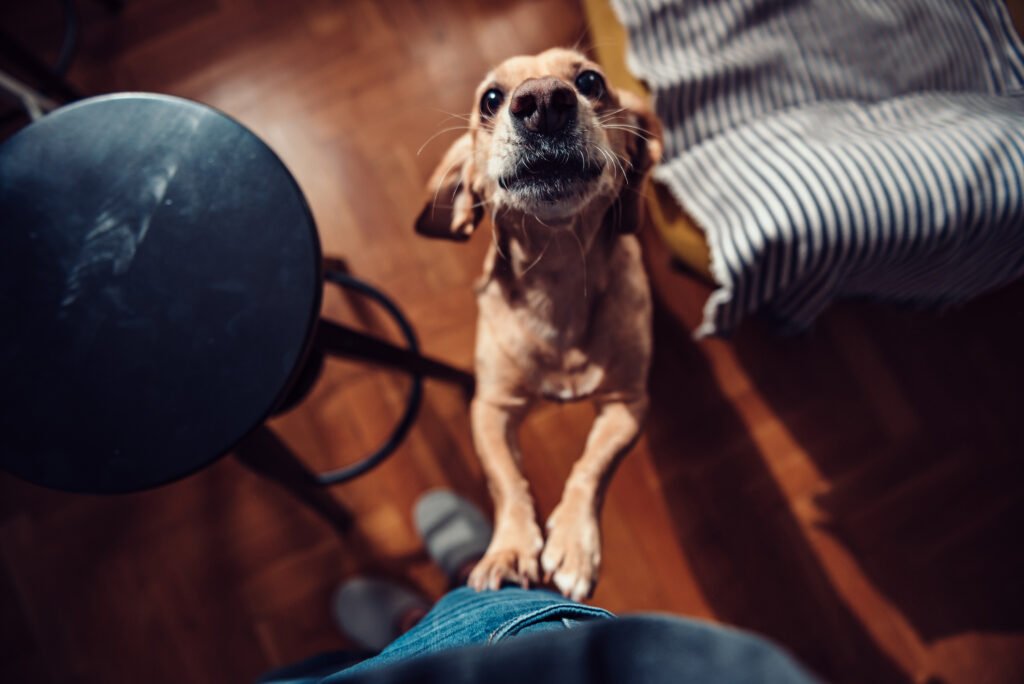Table of Contents
Have you ever wondered why so many dog owners believe their dogs are disobedient? Well, the truth is, it may not be entirely the dog’s fault. Humans can sometimes be poor communicators, which can contribute to perceived disobedient behavior. Common examples include pulling on the leash, jumping on furniture, jumping on people, and whining for food at the dinner table. The good news is, with clear communication and consistent rules, these behaviors can often be resolved. For example, pulling on the leash can be addressed by rewarding calm behavior, while jumping on furniture can be resolved by redirecting to a designated spot. By establishing clear rules and rewarding alternative behaviors, jumping on people can also be addressed. And as for whining for food at the dinner table, simply avoiding feeding the dog from the table and redirecting them to their bed can make a big difference. It’s important to remember that resolving disobedient behavior takes patience and discipline from the dog owner, but professional dog trainers can also be a valuable resource for assistance. With a little effort and understanding, your beloved furry friend can become a well-behaved companion.
Reasons why dog owners believe their dogs are disobedient

Behavior of the dogs
Many dog owners believe their dogs are disobedient because of certain behaviors they exhibit. Dogs may engage in behaviors such as jumping on furniture, pulling on the leash, jumping on people, and whining for food at the dinner table, which are often seen as signs of disobedience. However, it is important to understand that dogs are not intentionally being disobedient, but rather displaying natural instincts or seeking attention. By understanding and addressing these behaviors, dog owners can help their furry friends become more well-behaved.
Poor communication skills of humans
Another reason why dog owners may perceive their dogs as disobedient is due to the poor communication skills of humans. Dogs rely on verbal and non-verbal cues from their owners to understand what is expected of them. If human communication is unclear or inconsistent, dogs may not fully comprehend the desired behavior. It is crucial for dog owners to improve their communication skills in order to effectively convey their expectations to their canine companions.
Common examples of disobedient behavior

Pulling on the leash
One common example of disobedient behavior is when a dog pulls on the leash during walks. This behavior can make walks unpleasant and challenging for both the dog and the owner. Dogs often pull on the leash because they are excited or eager to explore their surroundings. To resolve this issue, clear communication is key. Dog owners should use consistent verbal cues, such as “heel” or “walk nicely,” and reward calm behavior with treats or praise. By providing clear expectations and positive reinforcement, owners can help their dogs learn to walk politely on a leash.
Jumping on furniture
Another behavior that many dog owners find disobedient is when their dogs jump on furniture. Dogs may do this to seek comfort or to be closer to their owners. However, allowing dogs to freely jump on furniture can lead to hygiene issues and damage to the furniture itself. Resolving this behavior requires consistent rules. Dog owners should establish designated areas where their dogs are allowed to rest, such as a dog bed or a specific blanket on the floor. By redirecting their dogs to these designated spots and consistently reinforcing the rules, owners can discourage the behavior of jumping on furniture.

Jumping on people
When dogs jump on people, it can be perceived as a sign of disobedience or lack of training. However, dogs often jump up to greet their owners or express excitement. To address this behavior, it is important to establish clear rules. Dog owners should teach their dogs an alternative behavior, such as sitting or offering a paw for a handshake, as a way to greet people. By consistently rewarding and reinforcing the desired behavior, dogs will learn to greet people politely without jumping.
Whining for food at the dinner table
Whining for food at the dinner table is another example of a behavior that dog owners may view as disobedient. Dogs are naturally food-motivated, and they may whine in the hopes of getting a tasty treat or leftover scraps. To resolve this behavior, it is important for owners to avoid feeding their dogs directly from the table. Instead, dogs should be fed their own meals in designated areas, such as their crate or a separate room. By redirecting their dogs to these designated feeding spots and consistently reinforcing the rule of not feeding from the table, dog owners can discourage the behavior of whining for food.
Resolving pulling on the leash

Clear communication
To resolve the issue of pulling on the leash, clear communication is essential. Dog owners should use consistent verbal cues, such as “heel” or “walk nicely,” to convey their expectations to their dogs. It is important to use these cues consistently and to avoid mixed signals. Additionally, using non-verbal cues, such as a gentle tug on the leash or a change in direction, can also help communicate the desired behavior. By providing clear and consistent communication, dog owners can guide their dogs to walk calmly on the leash.
Rewarding calm behavior
In addition to clear communication, rewarding calm behavior is an effective way to address pulling on the leash. When the dog walks calmly by the owner’s side without pulling, the owner should praise the dog and offer treats or a favorite toy as a reward. By associating calm behavior with positive reinforcement, the dog will learn that walking nicely on the leash leads to rewards. Consistency in rewarding calm behavior will encourage dogs to continue exhibiting the desired behavior.
Resolving jumping on furniture

Consistent rules
To resolve the behavior of jumping on furniture, consistent rules must be established. Dog owners should make it clear to their dogs that jumping on furniture is not allowed. This can be communicated through verbal cues such as “off” or “down” and reinforced consistently. It is crucial for all members of the household to enforce these rules consistently to avoid confusion. By setting and enforcing consistent rules, dogs will learn that jumping on furniture is not acceptable behavior.
Redirecting to a designated spot
In addition to consistent rules, it is important to redirect dogs to a designated spot when they attempt to jump on furniture. Dog owners should establish a comfortable and inviting area for their dogs, such as a dog bed or a specific blanket on the floor. When the dog shows signs of wanting to jump on furniture, the owner should redirect the dog to the designated spot and reward them for staying there. By redirecting their dogs and providing an alternative comfortable spot, owners can discourage the behavior of jumping on furniture.
Resolving jumping on people
Establishing clear rules
To address the behavior of jumping on people, clear rules must be established. Dog owners should teach their dogs an alternative behavior, such as sitting or offering a paw for a handshake, as a way to greet people. This can be achieved through consistent training and reinforcement of the desired behavior. By setting clear rules regarding proper greetings, dogs will learn that jumping on people is not an acceptable behavior.
Rewarding alternative behaviors
In addition to establishing clear rules, rewarding alternative behaviors is essential in resolving the issue of jumping on people. When the dog greets someone in a calm and polite manner, the owner should praise the dog and offer treats or affection as a reward. By consistently reinforcing the desired behavior, dogs will learn that greeting people politely is more rewarding than jumping. Consistency in rewarding alternative behaviors will encourage dogs to engage in appropriate greetings.
Resolving whining for food at the dinner table
Not feeding from the table
To address the behavior of whining for food at the dinner table, it is important for dog owners to avoid feeding their dogs directly from the table. Dogs should be fed their own meals in designated areas, such as their crate or a separate room. This helps establish boundaries and prevents dogs from associating the dinner table with food. It is crucial for all members of the household to adhere to this rule and avoid giving in to the dog’s begging behavior.
Redirecting to their bed
In addition to not feeding from the table, dogs should be redirected to their bed when they exhibit the behavior of whining for food. Dog owners should establish a comfortable and inviting bed for their dogs and encourage them to go to their bed instead of begging at the table. When the dog goes to their bed, the owner can reward them with treats or praise. By consistently redirecting the dog to their bed and rewarding the desired behavior, owners can discourage the behavior of whining for food at the dinner table.
Importance of clear communication and consistency
Addressing disobedient behavior
Clear communication and consistency are crucial in addressing disobedient behavior in dogs. By clearly conveying expectations and using consistent cues, dog owners can help their dogs understand the desired behavior. It is important for all members of the household to be on the same page and enforce the rules consistently. Clear communication and consistency provide dogs with a sense of structure and stability, which can help reduce disobedient behaviors.
Establishing rules and boundaries
Clear communication and consistency also play a vital role in establishing rules and boundaries for dogs. When dogs understand what is expected of them and experience consistency in their environment, they feel more secure and confident. This, in turn, can lead to a decrease in disobedient behaviors. By providing clear rules and boundaries, dog owners create a positive and structured environment for their dogs to thrive in.
The role of patience and discipline in resolving unwanted behaviors
Consistency in training
Resolving unwanted behaviors in dogs requires patience and discipline from the dog owner. Consistency in training is key to addressing and overcoming these behaviors. Dog owners must be patient and persistent in applying the training techniques and strategies consistently. Dogs need time to learn and understand new behaviors, and it is important for owners to remain patient throughout the process.
Positive reinforcement
Positive reinforcement is another important aspect of resolving unwanted behaviors in dogs. By rewarding desired behaviors with treats, praise, or affection, dog owners can motivate their dogs to continue exhibiting those behaviors. Positive reinforcement helps dogs understand what is expected of them and encourages them to repeat the desired behavior. It is important to focus on rewarding the positive instead of punishing the negative, as positive reinforcement is more effective in shaping desired behaviors.
Seeking assistance from professional dog trainers
Benefits of professional guidance
In some cases, seeking assistance from professional dog trainers can be beneficial in resolving disobedient behaviors. Professional trainers have the knowledge and experience to assess and address specific behavior issues in dogs. They can provide personalized guidance and training techniques that are tailored to the individual needs of the dog and the owner. Professional guidance can be especially helpful for complex or persistent behavior problems.
Getting personalized advice
When working with a professional dog trainer, dog owners can receive personalized advice and support. Trainers can assess the specific behaviors and circumstances surrounding the disobedient behavior and provide targeted strategies for resolution. They can also guide owners on proper training techniques and help them understand the underlying causes of their dog’s behavior. Getting personalized advice from a professional can greatly improve the effectiveness of training and behavior modification efforts.
In conclusion, many dog owners believe their dogs are disobedient due to certain behaviors they exhibit. However, it is important to understand that dogs are not intentionally being disobedient but may simply be behaving according to their natural instincts or seeking attention. By improving communication skills, addressing specific behaviors, and seeking professional guidance when needed, dog owners can help their dogs become well-behaved and better understand their expectations. Clear communication, consistency, patience, and positive reinforcement are key factors in resolving unwanted behaviors and creating a harmonious relationship between dog and owner.



